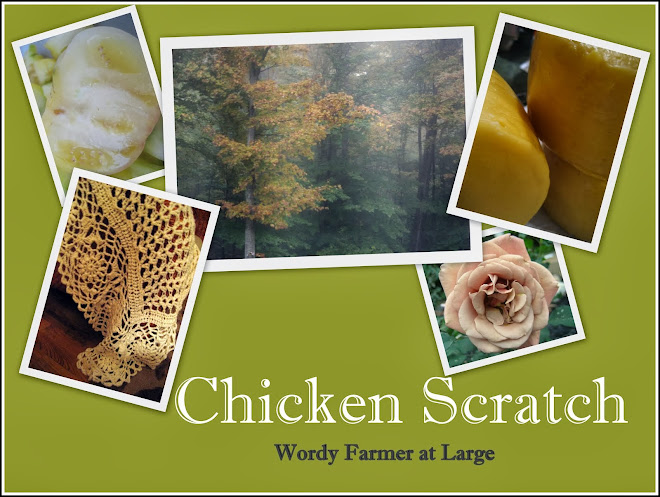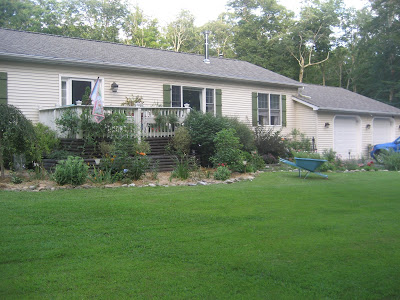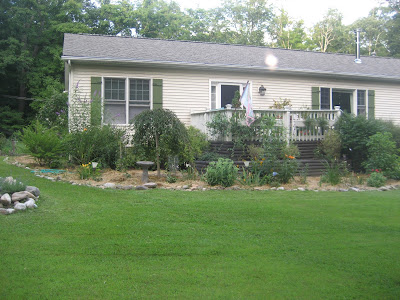 |
| Albert is also looking good. |
But will I stop there? Nah. With the rising cost of everything, the stagnation of salaries, and the possibility of big time economic problems (to put it politely) on the horizon, 3000 square feet is not enough, and it's time to expand again. I have a family to feed, you know. :) Now as you know, we have a nice little chunk of land, but not much of it is actually cleared. I'm loath to clear any more, truthfully, because it's just so damn nice, plus, in practicality, a lot of it is wet, and is better suited to grazing animals, like the goats or some pigs. Plus free firewood, how can you go wrong?? The area that is cleared is pretty much the best area for growing food on this piece, so I have to make the most of it.
To do that, I looked to a few more principles of permaculture--those of alley cropping, polycultures and guilds. Polycultures are nothing more than an area where several different crop types are grown in one space. They are the direct opposite of what is practiced in large scale in this country--monoculture-- or as I like to call it "Corn, corn, as far as the eye can see, and not a bit of it edible". Any person who has grown a garden of any size has practiced polyculture, unless all they did was say, grow tomatoes or beans and that was it. But does anyone really do that? No, so polycultures are not a foreign idea to anyone, I would think. The benefits are many, including the fact that if the year is a bad one for say, eggplant (which this one was in my garden), and all you planted was eggplant, then you'd starve (you'd probably starve anyway, since eggplant has very little nutritional value, but you get my drift). But if you planted many other things besides eggplant, then when the eggplant fails, it sucks, but you still have other things to eat. Ta da! It's a good system.
So ok, I already practice polyculture, and I know you all do too. So let's look at some other ideas, such as alley cropping and guilds. Both of these principles center around fruit trees, generally, and I happen to have some fruit trees. Kismet!
This is a shot of the orchard area, earlier this year. As you can see, and is the fact of almost all orchards, it's a bunch of fruit trees in a sea of grass. Basically, and especially when the trees are young like mine are, it's a huge waste of space, when space is at a premium. Now I did attempt to use a couple of plots in here this year, but they failed miserably because I didn't keep up with the weeding. My bad. All in all, I didn't use the space effectively. However, what you can see in this picture is alley cropping--using the space between the trees to grow another crop. Brilliant! Had it worked, it would have been a very good use of otherwise unused space.
So establishing that the principle of alley cropping is sound, and knowing that I need more space, I sought to create an area in this space that would allow me to use the land much more effectively. Honestly, I was stuck. The grass is so pervasive, and the soil here is pretty bad, so it was really vexing to think of how to do what I wanted to do without fighting a continuous battle. Luckily, my parents used to have a vegetable garden, full of raised beds. And they were no longer using it and were going to take it down. And because I love stuff people are getting rid of, I bartered that I would take it all apart, if I could have it. They agreed. After several hours of hard work, I took apart the boxes they had, loaded them into my car (and my dad's truck), and brought them home to reassemble. And now the orchard, which looked like the above, now looks like this:
 |
| Complete with fatty, fatty broilers |
I have no idea how much space I have added. I actually have to measure today, so I can start planning for next year's garden, so I'll let you know. But it is a use of the space that would not have been used, and better yet, it's all in neat boxes, which I like because I am so compulsive about that sort of thing.
The large, currently tarped areas are being solarized. They will be where I plant the hugely vining things, like the pumpkins and winter squash and melons. When in the garden, these plants eat the planet and severely limit my space to grow things in doing so. Out in these long runs, they can do as they please and not effect the other plants around them. The boxes? Well, I haven't really decided what to plant where yet, but they will be the annuals we all know and love. Honestly, I will probably use a good number of them for potatoes and garlic and things that need to grow down. The hard clayey soil here is not really friendly to things that like to grow down around here. I'll let you know what I decide!
The last principle that could be practiced here is the concept of guilds. Guilds are a group of different plants, growing together, that benefit one another as well as us. The above pics are not of a true guild, though I have in mind some ways to make it so. Potatoes will probably not benefit the fruit trees in any way, whereas if I planted some flowering somethings to attract pollinators, that would benefit the fruit trees, and the fruit trees would, in turn, benefit them. This area, as I need to intensely cultivate it for our food, is not for that. Instead I have set up a "test guild" area here:
I planted two additional fruit trees, a peach and an apple. I placed a tiered bed (from my parents' house) in the center. I will grow strawberries in here. Around that bed, and around the fruit trees, I will be planting lower fruiting bushes, herbs, and ground covers that will boost the productivity of all (hopefully). On the flip side, this area is one of runoff from the gutters. Though we do catch a good amount of the rain water, we never catch it all, and it goes off into this area here. I have been working this year to stop this, or at least slow it down, but it's been tough going. The plants here will be able to catch the water, benefit from it, and hopefully make the area less soggy for us. And in setting up this area, I am stacking functions, another permaculture principle (go me!). If it works, this will be a win-win situation. I hope it works.
Truly all these principles can work together to make areas run as a unified whole. Though I really do like things in their "proper" places, I am really interested to see how a cacophony of plants do together. Will they work together? Will it be productive (most important)? Or will it become an untamed jungle that I can't stand looking at, much less working in (my biggest fear)? Only time will tell, my friends. I think we'll all see together!






























